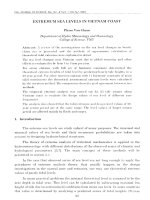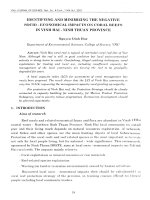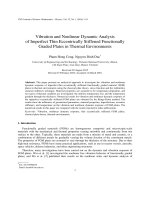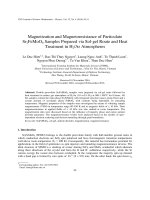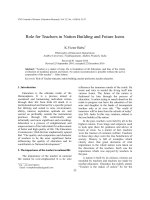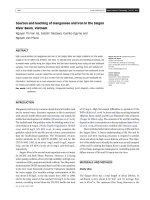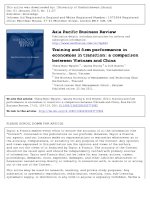DSpace at VNU: Trust and commitment in online shopping in Vietnam, antecedents and consequences
Bạn đang xem bản rút gọn của tài liệu. Xem và tải ngay bản đầy đủ của tài liệu tại đây (84.64 KB, 4 trang )
Trust and commitment in online shopping in
Vietnam, antecedents and consequences
Nguyễn Thành Trung Hiếu
Khoa Quản trị Kinh doanh
Luận văn Thạc sĩ ngành: Quản trị kinh doanh; Mã số: 60 34 05
Người hướng dẫn: Dr. Trần Doãn Kim
Năm bảo vệ: 2011
Keywords. Quản trị kinh doanh; Thương mại điện tử; Mua sắm
Content
TABLE OF CONTENTS
ACKNOWLEGEMENT ......................................................................................................... i
ABSTRACT ........................................................................................................................... ii
TÓM TẮT ............................................................................................................................. iv
TABLE OF CONTENTS ...................................................................................................... vi
LIST OF TABLES .............................................................................................................. viii
LIST OF FIGURES .............................................................................................................. ix
CHAPTER 1 INTRODUCTION ........................................................................................... 1
1.1. BACKGROUND ....................................................................................................... 1
1.2. PURPOSES AND RESEARCH QUESTIONS ........................................................ 2
1.3. METHODOLOGY .................................................................................................... 2
1.4. DEFINITIONS .......................................................................................................... 3
CHAPTER 2: LITERATURE REVIEW ............................................................................... 5
2.1 CUSTOMER RELATIONSHIP MANAGEMENT.................................................. 5
2.1.1 Trust ..................................................................................................................... 7
1
2.1.2. Commitment ....................................................................................................... 11
2.1.3 Loyalty ............................................................................................................... 16
2.1.4 Retention ............................................................................................................ 17
2.1.5 The relationship among commitment, trust, loyalty and retention.. 17
2.2 METHOD OF STATISCAL ANALYSIS ............................................................. 24
2.2.1 Correlation analysis............................................................................................ 24
2.2.2Multiple Regression ............................................................................................... 24
CHAPTER 3: METHODOLOGY ....................................................................................... 30
3.1 RESEARCH STRATEGY ...................................................................................... 30
3.2 DATA COLLECTION METHOD.......................................................................... 32
3.2.1 Sample size ......................................................................................................... 32
3.2.2 Questionnaire design .......................................................................................... 33
3.2.3 Data collection .................................................................................................... 36
3.3 DATA ANALYSIS ..................................................................................................... 37
3.3.1 Measurement of variables ................................................................................... 37
3.3.2 Independent variables ......................................................................................... 37
3.3.3 Dependent Variables ........................................................................................... 38
3.3.4 Methods of data analysis .................................................................................... 39
CHAPTER 4: FINDINGS AND CONCLUSION ................................................................ 40
4.1 DESCRIPTIVE STATISTICS ................................................................................... 40
4.2 CORRELATIONS ..................................................................................................... 41
4.3 HYPOTHESIS TESTING ......................................................................................... 42
4.3.1 The determinants of Trust ................................................................................... 43
4.3.2 The determinants of Commitment ...................................................................... 45
4.3.3 The determinants of Customer Loyalty .............................................................. 48
4.3.4 The determinants of Customer Retention ........................................................... 54
CHAPTER 5: CONCLUSION AND RECOMMENDATIONS .......................................... 62
5.1 DISCUSSION ............................................................................................................ 62
2
5.2 IMPLICATIONS ....................................................................................................... 65
5.3 RECOMMEDATIONS .............................................................................................. 67
5.3.1 Further research .................................................................................................. 67
5.3.2 For e-commerce in Vietnam ............................................................................... 68
REFERENCES .....................................................................................................................89
References
• Allen N. J. and Meyer J. P. (1990), The measurement and antecedents of affective,
continuance and normative commitment to the organization.
• Babbie E. R (2007), The practice of Social Research, 11th edition, United Stated of
America: Thomson Learning.
• Bennett R. and Gabriel H. (2001), Reputation, Trust and Supplier commitment: The
case of shipping company/seaport relationship. Journal of Business and Industrial
marketing, Vol. 16, No. 6, pp. 424-438.
• Cohen J., Cohen P., West S. G. and Aiken L. S. (2003), Applied Multiple Regression/
Correlation Analysis for the Behavioral Sciences. 3rd edition, United States of
America: Lawrence Erlbaum Associates, Inc.
• D. Gefen, E-commerce: the role of familiarity and trust, Omega 28 (2000) (6), pp.
725-737.
• Eastlick M. A., Lotz S. L. and Warrington P. (2006), Understanding online B-to-C
•
relationships: An integrated model of privacy concerns, trust and commitment,
Journal of Business Research, Vol. 59, pp. 877-886.
• Field A. (2005), Discovering statistics using SPSS, 2nd edition, Great Britain: SAGE.
• Garbarino E. and Johnson S. M. (1999), The different roles of satisfaction, trust, and
commitment in customer relationships. Journal of Marketing, Vol, 63, No. 2, pp. 7087.
• Gefen D., Karahanna E. and Straub D. W (2003), Trust and TAM in online shopping:
An integrated model. MIS Quarterly, Vol. 27, No. 1, pp.51 - 90.
• Gerpott T. J., Rams W. and Schindler A. (2001), Customer retention, loyalty and
satisfaction in the German Mobile cellular telecommunication market,
Telecommunication Policy, Vol 25, p 249 - 269.
Gummesson E. (1999), Total relationship marketing - Rethinking
marketing management: From 4Ps to 30Rs, 1st Edition, Bath: Butterworth
- Heinemann.
G. Hofstede, Culture's consequences: international differences in work- related values,
Sage, Beverly Hills, CA (1980).
S.L. Jarvenpaa and N. Tractinsky, Consumer trust in an internet store: a cross-cultural
3
•
•
•
•
•
•
•
•
•
•
•
•
•
•
validation, Journal of Computer-Mediated Communication 5 (1999) (2), pp. 1-35
Josang A., Ismail R. and Boyd C. (2007), A survey of trust and reputation systems for
online service provision. Decision Support Systems, Vol. 43, pp.618-644.
Kotler P., Keller K. L. and Lu T. (2009), Marketing management in China, Prentice Hall:
Singapore.
Kumar V. and Reinartz W. J. (2006), Customer relationship management - A databased
approach, 1st Edition. United States of America: John Wiley and Sons, Inc.
Methlie B. L. and Nysveen H. (1999), Loyalty of online bank customers. Journal of
Information Technology, Vol. 14, pp. 375 - 386.
Morgan R. M. and Hunt S. D. (1994), The Commitment-Trust theory of Relationship
Marketing, Journal of Marketing, Vol 58, p 20-38.
Oliver R. L (1999), Whence consumer loyalty?, Journal of Marketing, Vol. 63, p.33-44.
Oppenheim A. N. (2005), Questionnaire design, Interviewing and Attitude measurement.
2nd edition, King’s Lynn: Pinter Publications.
Payne A. and Frow P. (2005), A strategic Framework for customer relationship
management. Journal of Marketing, Vol 69, p. 167-176.
Peelen E. (2005), Customer relationship management, 1st Edition. England: Pearson.
Phelps J., Nowak G. and Ferrell E., (2000), Privacy concerns and Consumer willingness
to provide Personal Information, Journal of Public Policy and Marketing, Vol. 19, No. 1,
pp. 27 - 41.
Ping A. R. (1993), The effects of satisfaction and structural constraints on retailer
exiting, voice, loyalty, opportunism, and neglect. Journal of Retailing, Vol. 69, No. 3,
pp. 320 - 352.
Porter M. E. (1980), Competitive Strategy: Techniques for Analysing Industries and
Competitors, London: Collier Macmillan..
Teo T. S. H and Liu J., (2007), Consumer Trust in E-commerce in the United States,
Singapore and China, The International Journal of Management Science, Vol 35, p 2238.
Turban E. and King D. (2003), Introduction to E-commerce, Prentice Hall: United States
of America.
4
